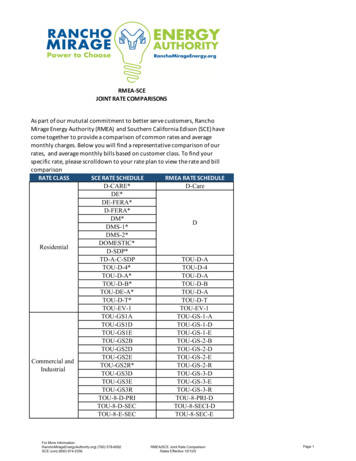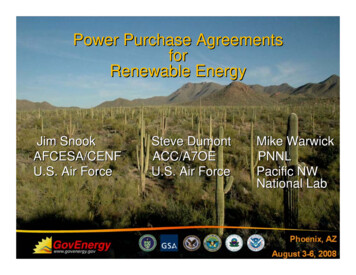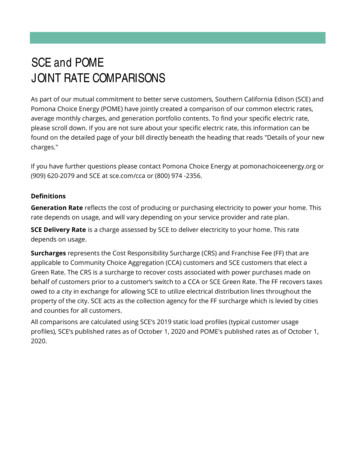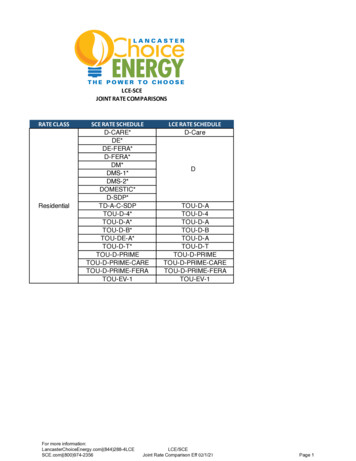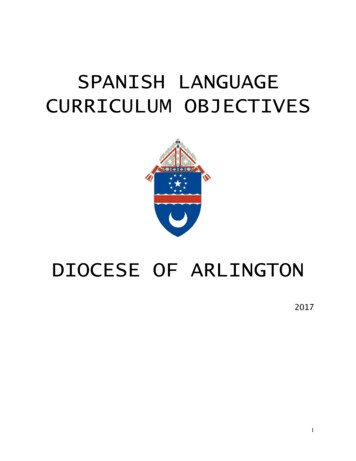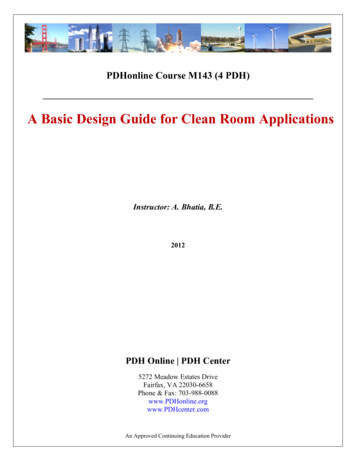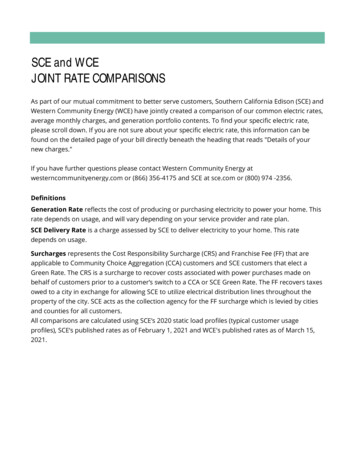
Transcription
Identifying clean, affordable and renewablecooking solutions for local people on InhacaIsland in MozambiqueErica DragonJohanna TaflinBachelor of Science ThesisKTH School of Industrial Engineering and ManagementEnergy Technology EGI-2015SE-100 44 STOCKHOLM
Keywords: Clean cooking, Mozambique, Inhaca Island, deforestation, renewable energy-I-
Bachelor of Science Thesis EGI-2015Identifying the affordable and sustainablesources of energy for local people on InhacaIsland in MozambiqueErica DragonJohanna TaflinApprovedExaminerSupervisorCatharina ErlichCatharina ErlichCommissionerContact personGabriel Albano-II-
This study has been carried out within the framework of the Minor Field Studies ScholarshipProgramme, MFS, which is funded by the Swedish International Development Cooperation Agency,Sida.The MFS Scholarship Programme offers Swedish university students an opportunity to carry out twomonths’ field work, usually the student’s final degree project, in a country in Africa, Asia or LatinAmerica. The results of the work are presented in an MFS report which is also the student’s Bacheloror Master of Science Thesis. Minor Field Studies are primarily conducted within subject areas ofimportance from a development perspective and in a country where Swedish internationalcooperation is ongoing.The main purpose of the MFS Programme is to enhance Swedish university students’ knowledge andunderstanding of these countries and their problems and opportunities. MFS should provide thestudent with initial experience of conditions in such a country. The overall goals are to widen theSwedish human resources cadre for engagement in international development cooperation as well asto promote scientific exchange between universities, research institutes and similar authorities as wellas NGOs in developing countries and in Sweden.The International Relations Office at KTH the Royal Institute of Technology, Stockholm, Sweden,administers the MFS Programme within engineering and applied natural sciences.Erika SvenssonProgramme OfficerMFS Programme, KTH International Relations Office-III-
AbstractInhaca Island is situated outside Maputo in Mozambique and is one of the globally importantareas for forest conservation. The forest provides a number of societal, environmental andeconomic goods. Electricity and LPG are available on the island but is for most people tooexpensive to use for the household’s most energy intensive activities, such as cooking. Instead, allof the 25 interviewed households use firewood for all or some of their cooking activities. The useof firewood on the island is unsustainable and is causing deforestation. Also, the combustion ofbiomass inside houses causes indoor air pollution, which leads to an increased risk of infection tothose who are exposed. To significantly reduce or end the use of firewood for cooking within anear future three renewable alternative cooking methods have been identified: solar cookers,biogas digesters and wood stoves. These solutions do not require new logistical solutions ortransport of fuel to or on Inhaca Island, which is important since roads and transport possibilitiesare poor on the island.Households with no fuel cost have little money to spend on a new solution and without helpfrom outside investors or the government, alternatives are slim. An improved cook stove or awood stove in the lower price range might be possible for these families to purchase and themain argument is a potential time save and improved health.With a fuel expense for the household of 50 USD per year, panel cookers are the best financialoption. Wood stoves could also be a good alternative in spite of the higher financial risk. A woodstove would slow down deforestation more than a panel cooker would.If the household spends 200 USD annually on fuel for cooking, and has enough animals andorganic waste to produce a sufficient amount of biogas, a fixed dome biogas digester is the bestalternative. A fixed dome biogas digesters require a very large initial investment and mighttherefor not be possible to implement without part time payments, subsidies or loans. Float drumdigester is also an alternative and is less expensive than the fixed dome digester. Other goodalternatives are parabolic solar cookers or wood stoves and here the choice between comfort andfinancial gain will decide which solution is most suitable for the family.For a household spending 500 USD on fuel for cooking annually, the conclusion is the same asfor the group spending 200 USD per year with the addition of a balloon digester. All digesters arestill expensive options and if the family is already spending 500 USD on fuel it is because theyalready use some comfortable fuels such as gas or electricity. It is therefore unlikely that theywould surrender some of this comfort to have a solar cooker, requiring more time, cannot smokeand is not compatible with all the current equipment. A wood stove would therefore probably bepreferred over a solar cooker.-IV-
SammanfattningInhaca är en ö utanför Mocambiques södra kust och dess unika natur erbjuder socialt,miljömässigt och ekonomiskt viktiga värden som bör bevaras. Det finns tillgång till elektricitetoch gas på ön men det är för de flesta hushållen för dyrt för att använda till de mestenergikrävande aktiviteterna så som matlagning. Istället använder alla de 25 intervjuade hushålleni studien ved till all eller delar av sin matlagning. Användning av ved från hushållen leder till attskogen på ön minskar och eftersom veden eldas i små och dåligt ventilerade hus och maten lagasöver öppen eld, leder den även till ökad risk för infektioner för de som lagar maten. För attavsevärt minska eller helt stoppa användningen av trä från skogen vid matlagning har trealternativa matlagningslösningar identifierats; sol-spisar, biogasenheter och vedspisar. Dessalösningar kommer inte att kräva nya logistiska lösningar eller skapa ett ökat transportbehov förbränsle till eller på ön. Detta är viktigt eftersom öns vägar är dåliga och transportmöjligheter tilloch från ön är begränsade.Hushåll utan ekonomiska möjligheter till utgifter för bränsle idag har inte råd att spendera pengarpå en ny matlagningslösning och utan finansiell hjälp utifrån är alternativen få. En vedspis i enlägre prisklass kan vara möjlig för familjerna att köpa och det huvudsakliga argumentet är denpotentiella tidsbesparingen och den förbättrade hälsan, givet att spisen har en skorsten.Med en årlig bränslekostnad på 50 USD kommer en solpanelspis vara det finansiellt bästaalternativet, men sett till sociala faktorer så framstår vedspisar som ett bra alternativ trots denhögre finansiella risken. Med en vedspis minskar dessutom användningen av ved mer än om ensol-spis används.Om hushållen spenderar 200 USD per år på bränsle för matlagning, och dessutom har mängdendjur och annat organiskt avfall för att producera tillräckligt med biogas, så är en fast biogasenhetett alternativ tillsammans med en floating biogasenhet. Eftersom dessa enheter kräver en mycketstor grundinvestering hjälper möjligheter till delbetalningar, bidrag eller lån för att investeringenska vara genomförbar. Andra bra alternativ är parabol-formade sol-spisar eller vedspisar. Dettaeftersom vedspisar är mer kompatibla med hushållens nuvarande utrustning och metoder ochdessutom sannolikt kräver kortare tid för tillagning av mat än en sol-spis, kommer valet att ståmellan den mer finansiellt motiverade paraboliska sol-spisen och en vedspis som är mer socialtmotiverad på grund av att den liknar dagens lösning.För hushåll som spenderar 500 USD per år på bränsle är slutsatsen densamma som för hushållensom spenderar 200 USD med tillägget av en ballong biogasenhet. En biogasenhet måstefortfarande ses som en mycket stor grundinvestering för denna grupp och det krävs även fördessa hushåll möjlighet till delbetalningar, bidrag eller lån för att investeringen ska varagenomförbar. Eftersom familjen redan spenderar 500 USD på bränsle för matlagning kan detantas att detta beror på en högre grad av användning av mer bekväma bränslen så somelektricitet. Det är därför mer osannolikt att denna grupp är villig att minska sin bekvämlighetoch välja en sol-spis. Vid val av ett billigare alternativ än biogas kommer därför någon avvedspisarna vara de troligaste alternativen för hushåll i denna grupp, men många alternativ ärmöjliga.-V-
AcknowledgementsFirst of all we would like to thank Sida together with KTH for giving us the scholarship andthereby making the execution of this bachelor’s thesis possible. We would also like to thank Mr.Gabriel Albano and the Eduardo Mondlane University for receiving us and guiding us in this projecttogether with our supervisor in Sweden, Catharina Erlich. Illario Timba, our guide and translator,has been of significant importance providing us with his knowledge of the island and fulldedication. Without him this project would not have been feasible.Last but not least we would like to thank the staff on Estacão de Biologia Maritima da Inhaca and thepeople we interviewed on Inhaca Island for their kindness and understanding and for sharinginformation about their lives with us.Erica Dragon and Johanna Taflin, 2015-05-31-VI-
Table of ContentsAbstract . IVSammanfattning . VAcknowledgements . VITable of Figures . IXTable of Tables . XIAcronyms.XIINomenclature . XIII12Introduction . 11.1Problem Formulation . 41.2Aim . 4Mozambique . 52.1Mozambican history . 52.2Nature of Inhaca Island . 62.2.1342.3Society on Inhaca Island . 92.4Energy on Inhaca Island . 102.4.1Electricity on Inhaca Island.102.4.2Biomass.11Cooking methods . 143.1Three stone fire . 143.2Adoption process of a new cooking solution . 143.3Alternative renewable cooking methods . 153.3.1Solar cooking .153.3.2Biogas .193.3.3Wood stoves .22Methodology . 254.1Minor Field Study . 254.2Methodology of results and discussion . 254.3Boundaries of the study . 284.3.14.45Weather and insolation on Inhaca Island. 7Questionnaire .28Equations . 30Results and discussion . 325.1Current energy use, social patterns and attitudes . 325.2Social evaluation. 37-VII-
5.2.1Solar Cookers.375.2.2Biogas .385.2.3Wood stoves .395.2.4Social ranking of the cooking solutions .405.3Financial evaluation . 415.3.1Households with an annual fuel expense of 50 USD .435.3.2Households with an annual fuel expense of 200 USD .435.3.3Households with an annual fuel expense of 500 USD .445.4Sensitivity analysis . 465.5Final discussion . 485.5.1Households with no fuel cost .495.5.2Households with an annual fuel expense of 50 USD .495.5.3Households with an annual fuel expense of 200 USD .495.5.4Households with an annual fuel expense of 500 USD .506Conclusion . 507Future work. 51References . 52Appendix A: Questionnaire . 61Appendix B: Animals and agricultural waste in households . 64Appendix C: Exchange rates . 65-VIII-
Table of FiguresFigure 1. Electricity use in households in Botswana, Ghana, Senegal and Honduras.Figure 2. Energy ladder.Figure 3. Map of Mozambique.Figure 4. Map of Inhaca IslandFigure 5. Roads on Inhaca Island.Figure 6. A map which describes the insolation with different coloursFigure 7. Monthly average rainfall at Inhaca IslandFigure 8. Population distribution on Inhaca IslandFigure 9. Composition of a biomass fuel.Figure 10. Correlation between moisture rate and LHVFigure 11. Three Stone Fire (TSF)Figure 12. A Box Cooker with a reflector and a glass cover to keep heat from escaping the potFigure 13. A typical panel solar cooker with a plastic bag concealing the pot in order to increase efficiencyFigure 14. Parabolic CookerFigure 15. Fixed dome plantFigure 16. Floating drum digesterFigure 17. Tube or balloon digesterFigure 18. Improved cook stoveFigure 19. A manufactured rocket stove with a tall combustion chamber and a small fuel magazine.Figure 20. Different stages of the projectFigure 21. Sustainability modelFigure 22. Model regarding social sustainabilityFigure 23. How many sources of energy that are used for cooking in the householdFigure 24. Relationship between number of fuels used in the household and the household’s income level.-IX-
Figure 25. Answers to the question “Do you see a problem with the current use of firewood on Inhaca and thedeforestation?”Figure 26. Sensitivity analysis of the payback time depending on the utilization of the solar cooker for ahousehold with an annual fuel expense of 50 USD-X-
Table of TablesTable 1. Benefits of Cleaner CookingTable 2. Monthly average rainfall at Inhaca Island.Table 3. Electricity tariffs on Inhaca IslandTable 4. Correlation between moisture rate and LHV.Table 5. LHV of some types of agricultural waste on Inhaca.Table 6. Data for different models of solar cookers. These are the prices that are offered in different stores online.Table 7. Biogas production from selected substratesTable 8. A summary of the data presented in the text.Table 9. The results from a field study in rural Uganda and Tanzania.Table 10. Fuels sold on Inhaca Island that are used for cookingTable 11. The number of households using different types of fuelsTable 12. Household financialsTable 13. Average cooking times and frequencies for different common dishes on Inhaca IslandTable 14. Social ranking of the cooking solutionsTable 15. Payback time for different cooking solutionsTable 16. Describes the Economic Gains for different scenarios of lifetimes and payback times when investing indifferent cooking solutions for the different groups. LLT Long Lifetime, SLT Short Lifetime, LPBT Long Payback time, SPBT Short Payback time.Table 17. A summary of the financial recommendations-XI-
AcronymsCIACentral Intelligence Agencyd.bDry BasisFUANEFundo De EnergiaGACCGlobal Alliance for Clean Cook stovesICTInformation Communication and TechnologyIEAInternational Energy AgencyIRENAInternational Renewable Energy AgencyLLTLong LifetimeLPBTLong Payback TimeLPGLiquefied Petroleum GasNASANational Aeronautics and Space AdministrationOECDOrganisation for Economic Co-operation and DevelopmentSIDAThe Swedish International Development Cooperation AgencySLTShort LifetimeSPBTShort Payback TimeTSFThree Stone FireTVTele VisionUNUnited Nationsw.bWet BasisWHOWorld Health Organization-XII-
Energy need in household[MJ]𝐸𝑢𝑠𝑒Energy use in ���𝑑Biogas yield[m3/kg DM]𝑡𝑐𝑜𝑙𝑙𝑒𝑐𝑡Time spent on collecting wood[h/month]𝑡𝑐𝑜𝑜𝑘𝑖𝑛𝑔 𝑚𝑒𝑡ℎ𝑜𝑑Cooking time of the cooking method[h/month]𝑡𝑑𝑖𝑓𝑓Time saved or lost due to changed cooking method[h/month]𝑡𝑡ℎ𝑟𝑒𝑒 𝑠𝑡𝑜𝑛𝑒 𝑓𝑖𝑟𝑒Cooking time of the three stone fire[h/month]𝜂𝑐𝑜𝑜𝑘𝑖𝑛𝑔 𝑚𝑒𝑡ℎ𝑜𝑑Efficiency of the cooking method[%]CUnitElectricity cost[USD/month]DMDry MatterfFuel consumption in householdGInitial investment[USD]jType of animal or humanj 1,2,3,4LHVLower Heating Value[MJ/kg]LHVdryLower Heating Value for dry wood[MJ/kg]LHVwetLower Heating Value for wet wood[MJ/kg]LTLife time[years]MCdryMoisture Content on dry basis[%]MCwetMoisture Content on wet basis[%]P[%]Economic gain[kg/person/day][USD]PBPayback time[years]SavingSaving per year from reduced fuel cost[USD/year]TariffElectricty tariff[USD/MJ]WasteAgricultural waste and food waste𝑠Standard deviation-XIII-[kg/year]
1IntroductionInhaca is an island situated in the Maputo bay in southern Mozambique. The island is made ofsand with its highest level situated 104 meters above the sea. There are swamps, mangroves,cultivated fields, grassy plains and dune forests. The flora and fauna are rich with a large varietyof rare species. (Albano, 2015)In spite of Inhaca’s connection to the mainland grid, established in 2003 (AllAfrica, 2003), 90 %of the inhabitants of Inhaca Island were in 2015 estimated to cook over open fire using firewood.Wood is also used for construction. The high level of wood use leads to deforestation, which hasan adverse effect on the unique nature on the island. (Albano, 2015)At the moment, the amount of firewood used for cooking on Inhaca Island, and other parts ofMozambique, is unsustainable and the resources of forest will not be able to meet the growingdemand. With the forest gone on Inhaca Island, there is a risk of planation and loss of abiodiversity hotspot. Policy makers are aware of the problem with deforestation and initiatives,such as improved access to gas and kerosene, a fund for rural electrification (FUNAE) and asyllabus including studies of renewable energy at Eduardo Mondlane University’s Faculty ofScience and Faculty of Engineering, have been initiated to find more sustainable solutions.(IRENA, 2012)When poor households first get access to electricity, they primarily use it for lighting, TV, radioand a few other appliances and not for the most energy intensive activities such as cooking,heating of water or space heating as illustrated in figure 1. For the very poor, firewood mayremain the primary fuel for cooking simply because it often can be collected for free, with onlythe expenditure of time and labour. (Prasad, 2008)Figure 1. Electricity use in households in Botswana, Ghana, Senegal and Honduras. (Prasad, 2008)Figure 1 illustrates that the majority of the households who gained access to electricity used it forlighting whilst only 0-22 % of the households used the electricity for the more energy intensiveactivities; cooking and water heating. In Ghana and Senegal; none of the households useelectricity for cooking or water heating. They remain multiple-fuel users because they cannotafford more electricity although they would prefer to use electricity more extensively. (Prasad,2008)A reduced use of wood as cooking fuel also has a positive impact on health. About 600 000people in Africa, mostly women and children, die prematurely every year due to exposure to-1-
indoor air pollution from biomass. (IEA, 2014) Roots, fuel wood and agricultural residues emithigh levels of carbon monoxide, hydrocarbons and particulate matter when incinerated.(OECD/IEA, 2006)Access to electricity also makes it possible to have a fridge, where food and vaccines can bestored. The electricity gives increased access to information communication technologies (ICT:s)and access to good lightning makes it possible to study after dark. (WHO, 2006)If it would be possible to significantly reduce or end the use of firewood in the households itwould emancipate time and labour, previously used to collect firewood primarily by women, foreducation and other income generating activities. (Kanagawa and Nakata, 2007) A change tocleaner cooking, using better fuels, therefor has several benefits. If half the population indeveloping countries were to be provided with LPG from 2006 to 2015, who would otherwise beusing solid fuels for cooking, WHO estimates total benefits to reach 91 million dollars, as shownin table 1.Table 1. Benefits of Cleaner Cooking. (OECD/IEA, 2006)Source of savingHealth Care SavingsTime Savings due to prevented illnesses:School attendance days gained and productivity gainsTime savings due to less time spent on fuel collection and cookingValue of averted deathsEnvironmental benefitsTotal BenefitsAmount saved [Million USD]0.381.4643.9838.736.0790.62The largest contribution to this gain is from time savings in cooking and collecting wood and thesecond largest is the estimated value of averted deaths. The smallest contributor is from healthcare savings. This could be because people who are today using wood as their primary source ofenergy for cooking have a low income and therefore cannot afford health care, even whensubsidized. Healthcare might not also be available.Access to electricity does not automatically lead to development. As studied by Åkesson andNhate in 2002 in the Ribáuè electrification project, the development of commercial activity in thedistrict was hampered by lack of complementary infrastructure such as good roads,telecommunication, water and irrigation networks, banks and credit facilities.The choice of energy source for the households most energy intensive activities is muchdependent on the household income, and this correlation can be illustrated by an energy ladder,see figure 2. The energy ladder illustrates different fuels used for the most energy intensiveactivities in a household, such as cooking. The efficiency, cleanness and convenience of the fuelsincrease while moving up the ladder. This means that crop waste and dung are the mostinefficient choices of fuel and that electricity is the ideal fuel choice, with superior energyefficiency during high heat output. (WHO, 2006)-2-
Figure 2. Energy ladder. (WHO, 2006)Factors identified by WHO to stimulate movement higher up the ladder are prosperity anddevelopment. (WHO, 2006) Other studies regarding fuel choice have in some cases shownmovements backwards on the energy ladder, motivated by affordability and availability. (Lewisand Pattanayak, 2012; Hiemstra-van der Horst and Hovorka, 2008) In the longer perspective,prosperity and development on Inhaca Island would most likely lead to a movement up theladder and a transition or partial transition away from wood.It is urgent to reduce the use of wood on Inhaca and consequently it is pressing to findalternative cook stoves for the inhabitants in order to significantly reduce the harvesting of theforest. This will be an advantage for the nature as well as for the people living on the island. Thefocus of the study will be to suggest alternative cook stoves and fuels with less strain on theforest and less health risk for humans. The alternatives will be compared regarding costs andsocial sustainability.-3-
1.1Problem FormulationInhaca Island is one of the globally important areas for forest conservation and the forestprovides a number of societal, environmental and economic goods. In addition, the combustionof biomass inside houses causes indoor air pollution, which leads to an increased risk of chestdecease to those who are exposed. (WHO, 2006) Inhaca urges for identification andimplementation of improved energy solutions for cooking. These solutions also have to bepossible to implement, use and finance. Unless the inefficient usage of the biomass stops,Inhaca’s population will experience a decrease in socio-economic development and the world willexperience a degradation of a biologically important area. In addition Inhaca’s population hasalready a widespread poverty and the island has limited space and resources. (Albano, 2015)1.2AimThe aim of this report is to identify renewable energy sources for cooking to replace orsignificantly decrease the current use of firewood from the forest. These sources should beevaluated from a financially and socially sustainable perspective in order to enable theirimplementation on Inhaca Island.The goal is to produce the following results: A description of the current energy use on the island. A model for adoption process of new cook stoves and a social sustainability assessmentbased on the model for the different solutions. Identify alternative cooking solutions that run on renewable fuel, significantly decrease orend the use of firewood for cooking and are affordable or profitable for households onInhaca Island, possibly with some financial aid from outside investors.-4-
2MozambiqueRepública de Moçambique is located in Sub-Saharan Africa and borders to Tanzania, Malawi,Zambia, Zimbabwe, South Africa and Swaziland. The climate is tropical to subtropical andnatural resources such as coal, titanium, natural gas, hydropower, tantalum and graphite can befound.(CIA, 2014) The population of Mozambique is estimated to about 25 million people andthe capital is Maputo, see figure 3. (SIDA, 2014a)Portuguese is the official language, but over 20 local languagesare spoken. Mozambique is still dependent on foreignassistance. In 2012 it represented 40% of the annual budgetand over 50% of the population remains below the povertyline.1 Agriculture
Electricity use in households in Botswana, Ghana, Senegal and Honduras. Figure 2. Energy ladder. Figure 3. Map of Mozambique. Figure 4. Map of Inhaca Island Figure 5. Roads on Inhaca Island. Figure 6. A map which describes the insolation with different colours Figu


